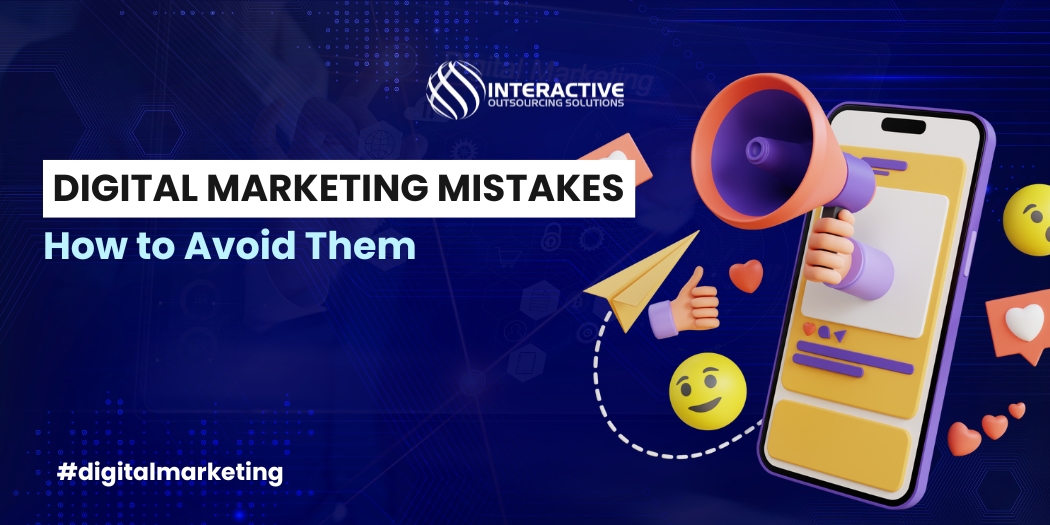Share
We live in a digital-first world, where your business’s success heavily depends on how well you market online. Digital marketing helps you reach the right audience, build your brand, and drive sales, but only if done correctly.
With complex strategies like SEO, content marketing, and paid ads, it’s easy to make marketing mistakes that hurt your growth. In this guide, we’ll walk through common digital marketing mistakes to avoid so you can adjust your strategy and get better results. Let’s dive in.
Common Digital Marketing Mistakes & How to Avoid Them
Even the best marketing strategies can fall apart if certain key elements are overlooked. Here are some common digital marketing mistakes to avoid so you can run a more effective campaign.
1. Not Setting Clear Goals
Jumping into digital marketing without clear goals is like sailing without a map, you won’t know if you’re headed in the right direction. Many businesses run campaigns without defining what success looks like, making it impossible to track progress.
How to avoid it: Set SMART (Specific, Measurable, Achievable, Realistic, and Time-sensitive) goals. For example, instead of saying, “Increase website traffic,” set a goal like, “Increase website visits by 20% in three months.” Use tools like Google Analytics to track progress and adjust your strategy as needed.
2. Targeting the Wrong Audience
Trying to reach “everyone” is one of the most common marketing mistakes businesses make. A broad audience might seem like a good idea, but it often leads to wasted resources and low engagement.
How to avoid it: Define your ideal customers by analyzing past buyers and creating buyer personas based on demographics, interests, and behaviors. If you sell athletic wear, for instance, your audience might include fitness enthusiasts, runners, or yoga practitioners. The more refined your targeting, the better your results.
3. Neglecting Website User Experience
Believe it or not, but a poorly designed website can drive away even the strongest potential customers. Slow loading times, difficult navigation, or a design that doesn’t work well on mobile devices can frustrate visitors and send them elsewhere.
How to avoid it: Make sure your website is mobile-friendly, loads quickly, and is easy to navigate. A clean layout, clear call-to-action buttons, and fast loading speeds improve the user experience. For example, major brands like Nike prioritize intuitive design, ensuring users can find products effortlessly.
4. Forgetting to Retarget Interested Customers
Many businesses focus on attracting new customers but overlook the importance of remarketing. If someone visited your site or added an item to their cart but didn’t complete the purchase, they might just need a reminder.
How to avoid it: Use remarketing strategies like personalized email reminders or targeted ads. For instance, if a customer leaves a pair of shoes in their cart, send them an email with a small discount or a reminder to complete the purchase. This simple nudge can increase conversions significantly.
5. Missing Out on Growing Brand Identity with Blogging
Blogging is a powerful tool for establishing authority and driving organic traffic, yet many businesses either don’t have a blog or abandon it too soon. Without consistent, high-quality content, you miss the opportunity to rank on search engines, educate your audience, and build trust.
How to Avoid This: Commit to a regular blogging schedule and create valuable content that addresses your audience’s pain points. Answer common industry questions, provide useful insights, and engage with readers in the comments. Over time, this will enhance your brand’s credibility and improve your search rankings.
6. Neglecting Social Media
Social media isn’t just for personal use, it’s a critical tool for businesses to engage with customers, increase brand awareness, and drive traffic. If you’re not active on social media, you’re missing out on a direct line of communication with your audience.
How to Avoid This: Identify the platforms where your audience is most active and create a consistent posting schedule. Share engaging content, interact with followers, and use social media to humanize your brand. If you want to reach a broader audience, consider investing in targeted social media ads.
7. Taking on Too Many Strategies Without Proper Resources
Many businesses try to implement multiple digital marketing strategies at once without the necessary time, budget, or expertise. This can lead to half-baked campaigns that fail to deliver results.
How to Avoid This: Focus on a few key strategies that align with your business goals and execute them well. If you lack the expertise, consider outsourcing tasks like SEO, content creation, or social media management to professionals who can help maximize your results. Quality always trumps quantity when it comes to digital marketing.
Final Thoughts
Digital marketing is a powerful tool when done right, but common mistakes can limit your success. By setting clear goals, targeting the right audience, maintaining a strong online presence, and focusing on quality over quantity, you can build a marketing strategy that drives real results. Avoid these blunders, and your digital marketing efforts will be far more effective in growing your business.






